Ever craved a lush, green oasis in your aquarium but worried about demanding plants? Ferns might be the perfect answer! This article is all about underwater charmers, addressing common concerns of how to plant ferns, like specific growth environments and pH requirements for types of fern plants. We’ll explore different fern types, helping you identify the ideal ones for your setup. From dazzling colors to diverse shapes, get ready to discover the perfect fern plant fit for your aquatic paradise.
Content Table
We’ll also discuss the top 10 popular fern plants for aquariums, detailing their characteristics and providing a roadmap for planting and propagation. So, buckle up, and let’s transform your aquarium into a thriving underwater jungle!

Types of fern plants
Ferns Plants
Ferns are commonly known as spore-producing non-flowering plants, containing neither seeds nor flowers. They are a group of plants of the most ancient species that date back to the Permian Period, beginning about 370 million years ago. Ferns exhibit an impressive diversity in shape and size and may be encountered in land or water habitats.
Common Fern Plants
Ferns are represented by at least 10,500 different species, but the numbers can vary widely depending on the estimate. Here are some of the most common fern families:
- Polypodiaceae: They are the largest group of ferns, representing more than 2,500 different species. The two common species of this family are probably the Boston Fern and the Maidenhair Fern.
- Blechnaceae: This group constitutes approximately 200 species of ferns, most of which inhabit the warm regions. The Sword Fern genus of the fern family is famous among plant lovers.
- Aspleniaceae: These families count nearly 700 fern species and they are distributed worldwide, living in many ways of our nature. The Bird’s Nest Fern is an example of a fern family.
Growth Environment and Habitat
Ferns are usually found in moist places where the light is not too strong. They prefer loose or sandy soil conditions, not dry soil. As for some fern species, they may like to grow in full sunlight so long as the soil is wet enough. The best soil pH for ferns may differ depending on the species but these targets range within an acidic area of 5.5 to 6.5.
Here are some examples of ferns that prefer specific pH values:
- Acid-loving ferns (pH 5.0-6.0): Maidenhair Fern, Foxtail Fern
- Neutral ferns (pH 6.0-7.0): Boston Fern, Leather Fern
- Calciphilic ferns (preferring alkaline soil, pH 7.0-8.0): Maidenhair Fern, Limestone Fern
Types of Fern Plants
Here are some of the most common and popular types of fern plants.
1. Maidenhair fern (Adiantum spp.)
|
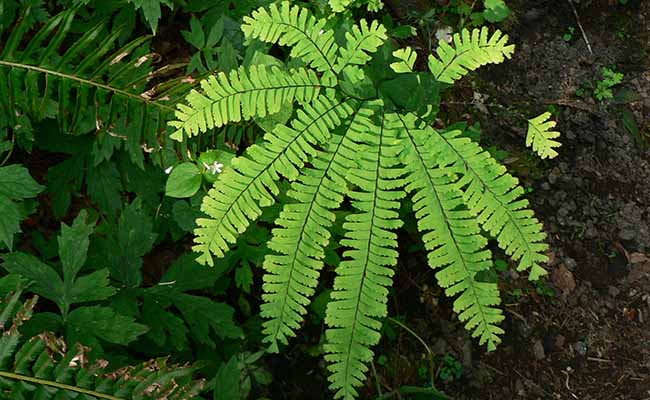 |
2. Lady fern (Athyrium filix-femina)
|
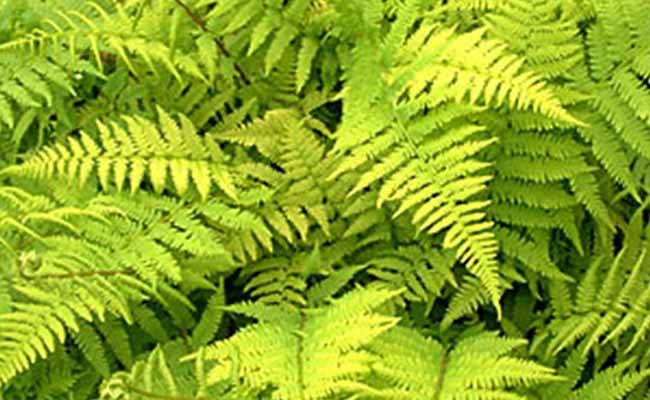 |
3. Sword fern (Polystichum munitum)
|
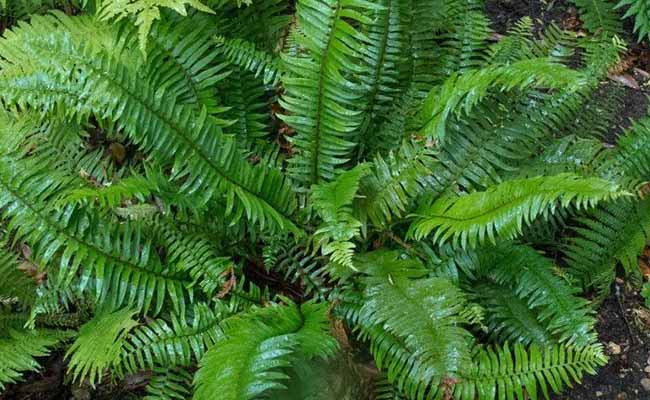 |
4. Ostrich fern (Matteuccia Struthiopteris)
|
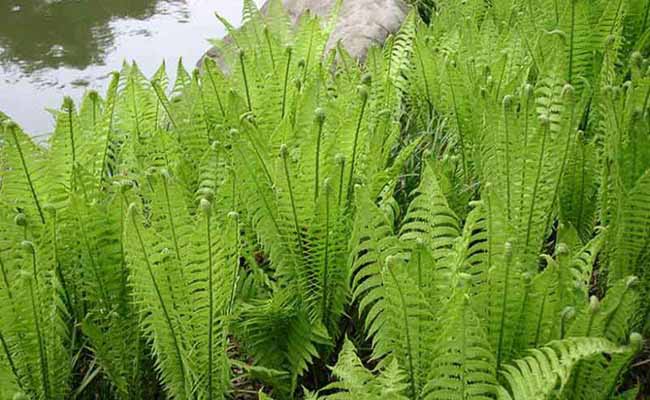 |
5. Cinnamon fern (Osmundastrum cinnamomeum)
|
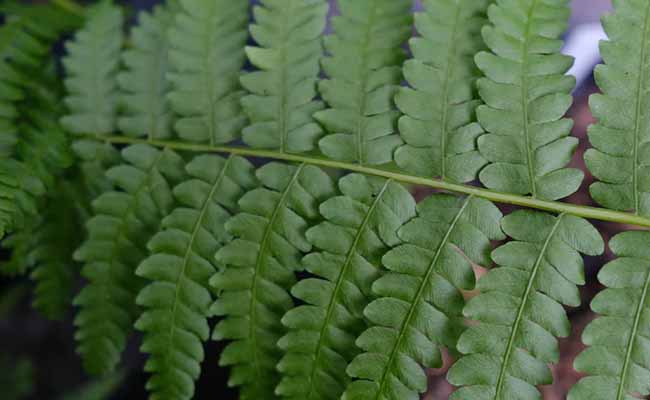 |
The Top 10 Popular Ferns for Aquariums
Here are the top 10 popular fern plants for aquariums, each with a detailed description of its characteristics.
1. Java Fern (Microsorum Pteropus)
| Color | Light to deep green | 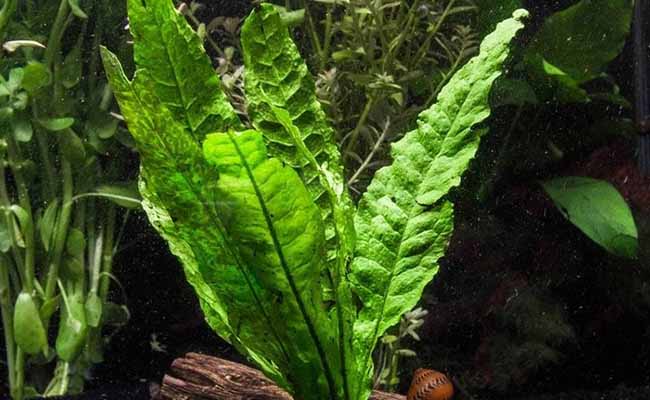 |
| Classification | Rhizome plant (doesn’t require substrate) | |
| Phyllotaxy | Alternate | |
| Leaf Shape | Long, pointed leaves with wavy edges and prominent central veins | |
| Lighting Requirements | Low to moderate light | |
| Growth Rate | Slow | |
| Breeding Difficulty | Easy (asexual reproduction through runners) | |
| Landscaping Area | Midground or background | |
| Suitable Temperature | 72-82°F (22-28°C) | |
| pH Range | 6.0-8.0 | |
| Hardness Range | Soft to moderately hard | |
| Planting Method | Attach to driftwood or rocks using cotton thread or gel super glue. Don’t bury the rhizome. | |
| Propagation Method | Division of the rhizome or removing baby ferns (plantlets) that grow on the mother plant. |
2. Anubias Barteri
| Color | Deep green, sometimes with brownish tinges | 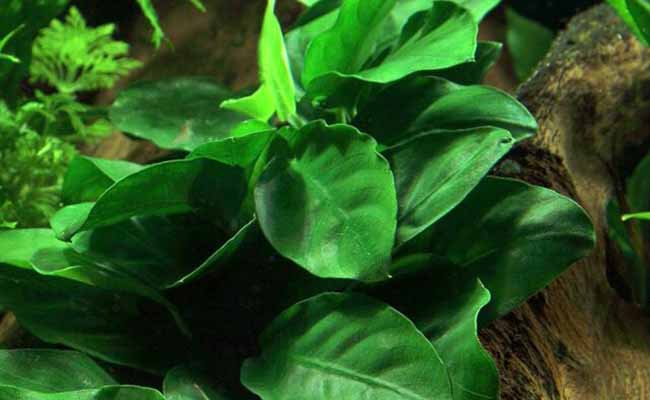 |
| Classification | Rhizome plant | |
| Phyllotaxy | Spiral | |
| Leaf Shape | Elliptical to lanceolate, with smooth or slightly wavy edges | |
| Lighting Requirements | Low to very low light | |
| Growth Rate | Slow | |
| Breeding Difficulty | Easy (asexual reproduction through rhizome buds) | |
| Landscaping Area | Midground or background | |
| Suitable Temperature | 72-82°F (22-28°C) | |
| pH Range | 6.0-8.0 | |
| Hardness Range | Soft to very hard | |
| Planting Method | Attach to driftwood or rocks using cotton thread or gel super glue. Don’t bury the rhizome. | |
| Propagation Method | Division of the rhizome or removing plantlets that sprout from the rhizome. |
3. Water Sprite (Ceratopteris Thalictroides)
| Color | Light to medium green | |
| Classification | Free-floating or rooted plant | |
| Phyllotaxy | Alternate | |
| Leaf Shape | Delicate, feathery leaves with a segmented appearance | |
| Lighting Requirements | Moderate to high light | |
| Growth Rate | Fast | |
| Breeding Difficulty | Easy (asexual reproduction through plantlets) | |
| Landscaping Area | Background or surface | |
| Suitable Temperature | 68-82°F (20-28°C) | |
| pH Range | 6.0-8.0 | |
| Hardness Range | Soft to moderately hard | |
| Planting Method | It can be planted on a substrate or allowed to float freely at the water’s surface. | |
| Propagation Method | Removal of plantlets that bud from the base of the mother plant. |
4. Bolbitis Heuskelli
| Color | Deep green | 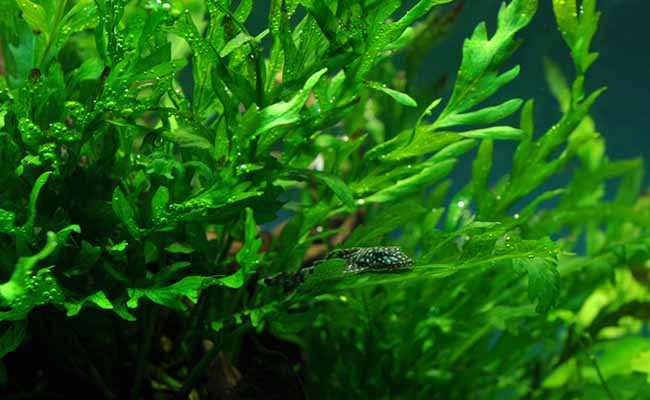 |
| Classification | Rhizome plant (doesn’t require substrate) | |
| Phyllotaxy | Clustered | |
| Leaf Shape | Narrow, strap-like leaves with wavy edges | |
| Lighting Requirements | Low to moderate | |
| Growth Rate | Slow to moderate | |
| Breeding Difficulty | Moderate (requires spores for sexual reproduction) | |
| Landscaping Area | Midground or background | |
| Suitable Temperature | 72-82°F (22-28°C) | |
| pH Range | 6.0-8.0 | |
| Hardness Range | Soft to moderately hard | |
| Planting Method | Attach to driftwood or rocks using cotton thread or gel super glue. Don’t bury the rhizome. | |
| Propagation Method | Division of the rhizome or removing plantlets that sprout from the rhizome. |
5. Microsorum Narrow Leaf (Microsorum Pteropus ‘Narrow Leaf’)
| Color | Light to medium green | 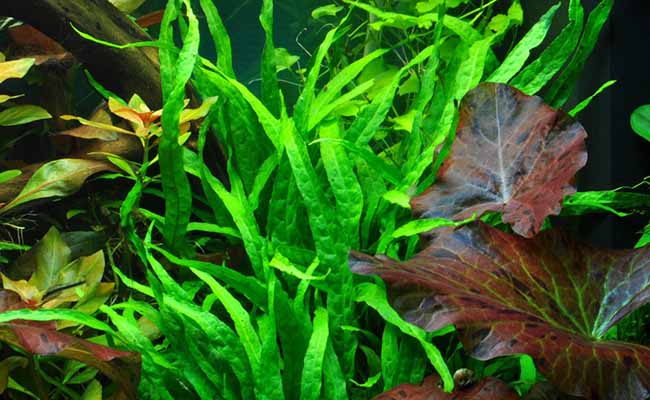 |
| Classification | Rhizome plant | |
| Phyllotaxy | Alternate | |
| Leaf Shape | Narrow, elongated leaves with smooth or slightly wavy edges | |
| Lighting Requirements | Low to moderate | |
| Growth Rate | Slow | |
| Breeding Difficulty | Easy (asexual reproduction through runners) | |
| Landscaping Area | Midground or background | |
| Suitable Temperature | 72-82°F (22-28°C) | |
| pH Range | 6.0-8.0 | |
| Hardness Range | Soft to moderately hard | |
| Planting Method | Attach to driftwood or rocks using cotton thread or gel super glue. Don’t bury the rhizome. | |
| Propagation Method | Division of the rhizome or removing baby ferns (plantlets) that grow on the mother plant. |
6. Bucephalandra Sp. (‘Buce’)
| Color | Green, with some varieties boasting shades of brown, red, or purple | 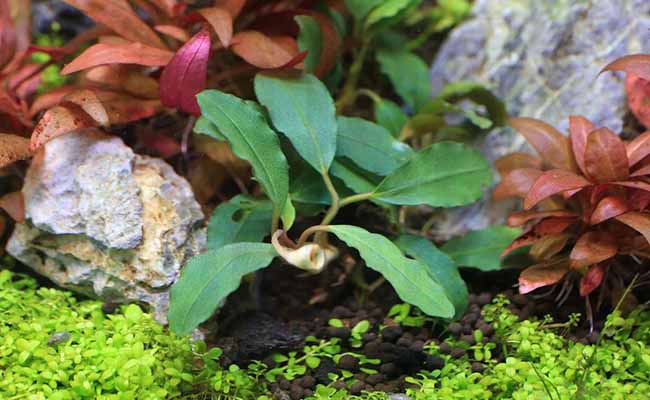 |
| Classification | Rhizome plant | |
| Phyllotaxy | Spiral | |
| Leaf Shape | Very diverse, ranging from narrow and lanceolate to round and elliptical. Some varieties have wavy or ruffled edges. | |
| Lighting Requirements | Low to moderate | |
| Growth Rate | Slow | |
| Breeding Difficulty | Moderate (requires spores for sexual reproduction) | |
| Landscaping Area | Foreground or midground | |
| Suitable Temperature | 72-82°F (22-28°C) | |
| pH Range | 6.0-8.0 | |
| Hardness Range | Soft to moderately hard | |
| Planting Method | Attach to driftwood or rocks using cotton thread or gel super glue. Don’t bury the rhizome. | |
| Propagation Method | Division of the rhizome or removing plantlets that sprout from the rhizome. |
7. Windelov Fern (Microsorum Pteropus ‘Windelov’)
| Color | Light to medium green | 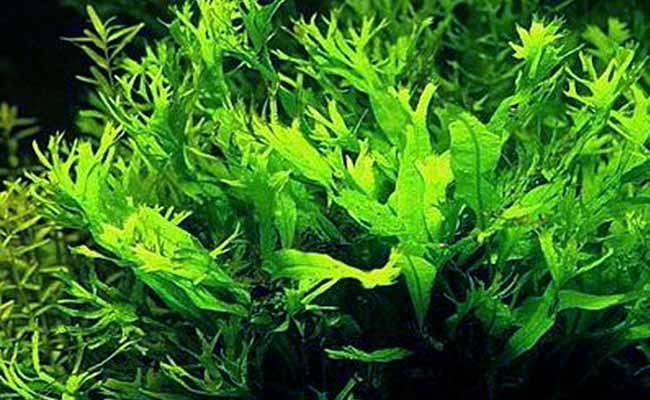 |
| Classification | Rhizome plant | |
| Phyllotaxy | Alternate | |
| Leaf Shape | Unique, with deeply lobed and forked leaves that resemble lace | |
| Lighting Requirements | Low to moderate | |
| Growth Rate | Slow | |
| Breeding Difficulty | Easy (asexual reproduction through runners) | |
| Landscaping Area | Midground or background | |
| Suitable Temperature | 72-82°F (22-28°C) | |
| pH Range | 6.0-8.0 | |
| Hardness Range | Soft to moderately hard | |
| Planting Method | Attach to driftwood or rocks using cotton thread or gel super glue. Don’t bury the rhizome. | |
| Propagation Method | Division of the rhizome or removing baby ferns (plantlets) that grow on the mother plant. |
8. Thai Fern (Microsorum Pteropus ‘Thai’)
| Color | Deep green, sometimes with a reddish tinge on the undersides of leaves | 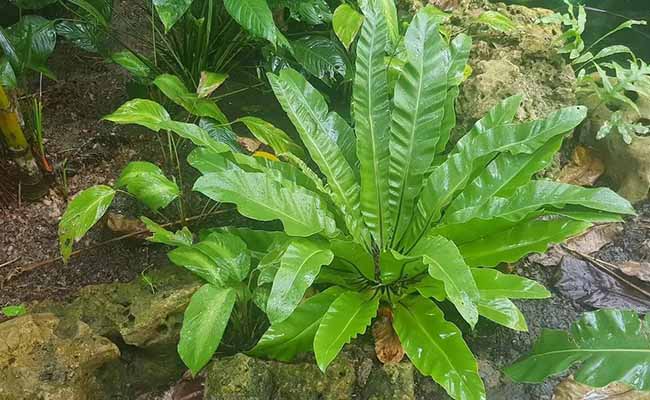 |
| Classification | Rhizome plant | |
| Phyllotaxy | Short and broad leaves with wavy or ruffled edges | |
| Leaf Shape | Four-lobed leaves resembling clover | |
| Lighting Requirements | Low to moderate | |
| Growth Rate | Slow | |
| Breeding Difficulty | Easy (asexual reproduction through runners) | |
| Landscaping Area | Midground or foreground | |
| Suitable Temperature | 72-82°F (22-28°C) | |
| pH Range | 6.0-8.0 | |
| Hardness Range | Soft to moderately hard | |
| Planting Method | Attach to driftwood or rocks using cotton thread or gel super glue. Don’t bury the rhizome. | |
| Propagation Method | Division of the rhizome or removing baby ferns (plantlets) that grow on the mother plant. |
9. Indian Water Fern (Hygrophila Pinnatifida)
| Color | Light to medium green | 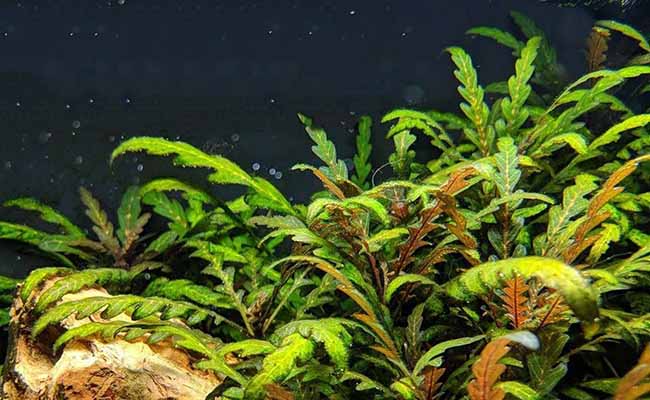 |
| Classification | Rhizome plant | |
| Phyllotaxy | Opposite | |
| Leaf Shape | Feathery leaves with deeply divided leaflets | |
| Lighting Requirements | Moderate to high | |
| Growth Rate | Moderate | |
| Breeding Difficulty | Easy (propagation through stem cuttings) | |
| Landscaping Area | Background or midground | |
| Suitable Temperature | 72-82°F (22-28°C) | |
| pH Range | 6.0-8.0 | |
| Hardness Range | Soft to moderately hard | |
| Planting Method | Rooted in the substrate | |
| Propagation Method | Stem cuttings. Pinch off the top portion of the stem and replant it in the substrate. |
10. Water Clover (Marsilea Quadrifolia)
| Color | Light to medium green | 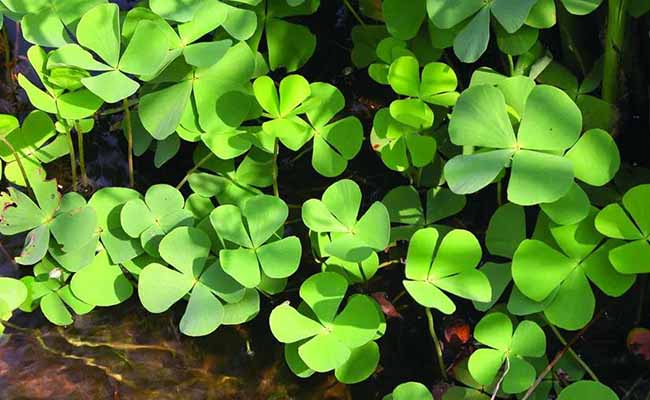 |
| Classification | Rhizome plant | |
| Phyllotaxy | Not applicable (four-lobed leaves) | |
| Leaf Shape | Four-lobed leaves resembling clover | |
| Lighting Requirements | Moderate to high | |
| Growth Rate | Moderate | |
| Breeding Difficulty | Easy (reproduces through spores) | |
| Landscaping Area | Foreground or midground | |
| Suitable Temperature | 68-82°F (20-28°C) | |
| pH Range | 6.0-8.0 | |
| Hardness Range | Soft to moderately hard | |
| Planting Method | Rooted in the substrate | |
| Propagation Method | Spores or division of the rhizome. Spore propagation is more challenging for beginners. |
How to Plant Ferns in Aquariums
Attaching the Ferns
You can use a variety of methods to attach the ferns in aquariums:
- Driftwood or Rocks: Ferns take up nutrients through their rhizomes. The most popular method of their attachment is to tie them to deadwood or stone.
- Super Glue Gel: Wipe a little glue all over the driftwood/rock and then attach the fern’s rhizome to it. Hold it for 30 seconds and let it air dry for several minutes before you put it back inside the tank
- Cotton Thread: The rhizome must be carefully tied to the driftwood or rock with cotton thread. The string will soon decompose once the fern has hooked itself.
- Wedging: Some ferns are smaller and can be tucked among crevices in driftwood or rocks.
Planting Tips
- Don’t Bury the Rhizome: The rhizome should be provided with support to keep it above the soil surface, not underneath it. Especially when they are buried, they result in a lack of absorption by plants, thus rotting.
- Placement: Ferns enjoy average to light flow. Put them in spots with water circulation so they can swim against the flow of water, but not directly under it.
- Lighting: Ferns can grow well even without very bright light. A relatively dim light condition appears to be optimal. A 5000K bulb is the preferred choice.
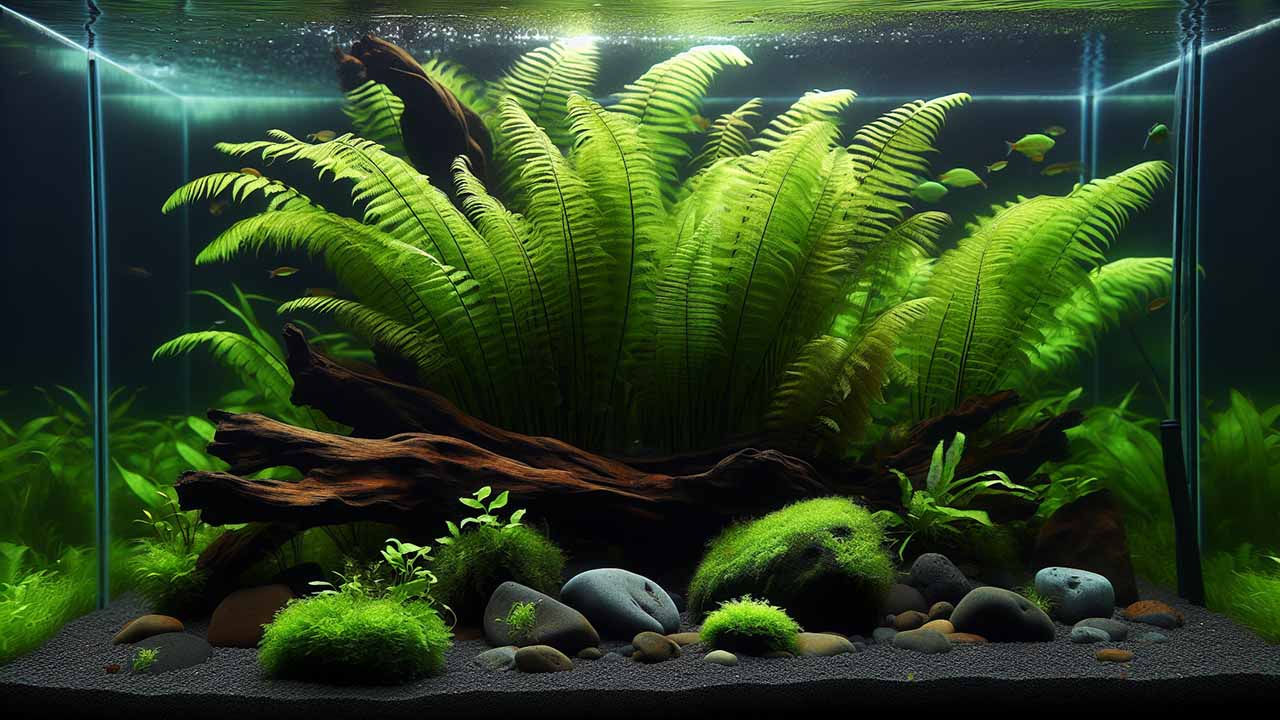
Popular fern plant for aquariums
In Summary
This article is about using ferns as an ornamental for a beautiful underwater world in your aquarium. Ferns are low maintenance and it is possible to choose from a wide range of species. The article examines the different types of ferns, their traits, and how to plant them. It also has information on how to do lighting and water movement so that you can have your fern-filled aquarium.
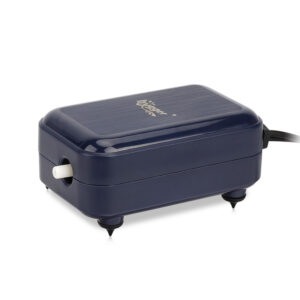
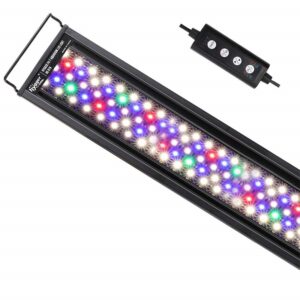
Leave a comment